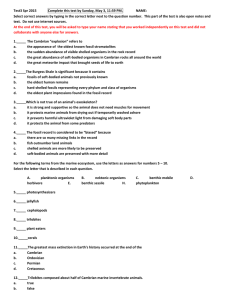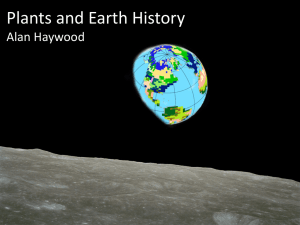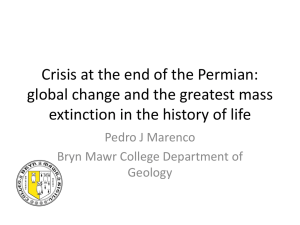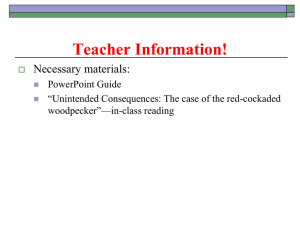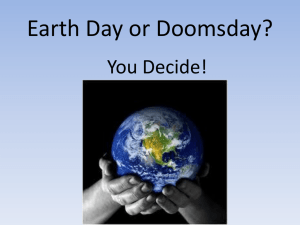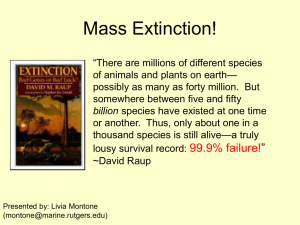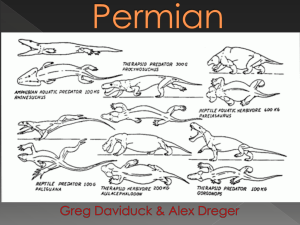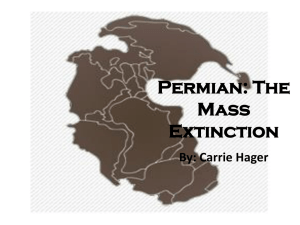UNIT-2-2014-DAY-1-PM-Instruction-Major Events in Earth History
advertisement
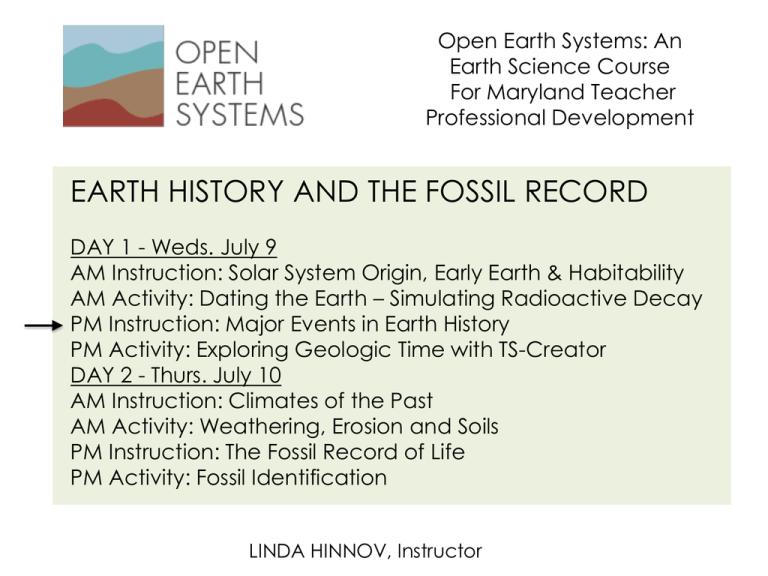
Open Earth Systems: An Earth Science Course For Maryland Teacher Professional Development EARTH HISTORY AND THE FOSSIL RECORD DAY 1 - Weds. July 9 AM Instruction: Solar System Origin, Early Earth & Habitability AM Activity: Dating the Earth – Simulating Radioactive Decay PM Instruction: Major Events in Earth History PM Activity: Exploring Geologic Time with TS-Creator DAY 2 - Thurs. July 10 AM Instruction: Climates of the Past AM Activity: Weathering, Erosion and Soils PM Instruction: The Fossil Record of Life PM Activity: Fossil Identification LINDA HINNOV, Instructor OUTLINE Origin of Moon Late Heavy Bombardment Plate Tectonics Great Oxidation Event Eukaryotes Snowball Earths Macrofossils Cambrian Explosion Life invades Land Mass Extinctions Introduction Earth history highlights J. Valley, Wisconsin Origin of Moon Canup, 2013 Late Heavy Bombardment Earth’s Impact History Late heavy bombardment Ocean vaporizing event Earth craters (filled boxes) Chiron (future) Moon craters (open boxes) From 4.0 to 3.8 Ga, the Late Heavy Bombardment occurred, which would have vaporized the ocean and exterminated any pre-existing life; accordingly, we name the upper Neohadean period Promethean. Kasting and Catling, 2003 Plate Tectonics “Faint young sun paradox” “Faint young sun paradox” One solution: Kasting, 1987 Another solution: Earth was closer to Sun Great Oxidation Event • • Stromatolites – 3.5 Ga – Suggest photosynthesis Biomarkers for cyanobacteria – 2.7 Ga Release of free oxygen into the atmosphere The boring billion Secular variation in d¹³C values of marine carbonates from 2.5 Ga to present. Triangles indicate times of extensive glaciation. Note extreme late Neoproterozoic isotopic variability and correlation at that time of negative excusions with glaciations. boring billion glaciation http://www.geol.umd.edu/~kaufman/iceages.html First eukaryotes Some of the earliest known single-celled eukaryote fossils are acritarchs, which become conspicuous at about 2.1 billion years ago. Acritarchs are the most common fossils of the late Proterozoic. Some are thought to have been the resting stages, or cysts, of dinoflagellates, which are one of the most prominent groups of planktonic algae today. Whatever their origin, the large size of many acritarchs (typically 60 to 200 microns or larger) indicates they were eukaryotes. Vendotaenid algae from Namibia. Image from D. Erwin, NMNH. http://paleobiology.si.edu/geotime/main/htmlversion/evidence/pro_01.html Snowball Earths boring billion Hoffman and Schrag, 2000 Macrofossils Ediacaran biota Macrofossils The Ediacaran Fauna from 600-545 million years ago - includes the earliest-known multicellular animals:. NMNH Diorama. Charnodiscus (large, orange sea pen); Ediacara (three large jellyfish); Dickinsonia (large segmented worm); and Spriggia (slender, green segmented worm) Plants invade Land A progressive increase in soil depth and geographic extent during the Devonian and Early Carboniferous is strongly associated with the development of plant rooting systems. Root traces become more frequent and extensive during the Middle Devonian, but most are still relatively shallow (<20 cm). DRAWDOWN IN ATMOSPHERIC CO2 Mass Extinctions End-Ordovician 1. Short event (~1 Myrs) Permian/Triassic 80-96% marine loss Cretaceous/Tertiary 60-75% marine loss 2. Disappearance of > 60% of species (> 10% families) 3. Global in scale End-Triassic Devonian Shaded band indicates the normal range of extinction rates, known as "background extinction." The peaks show the "Big Five" mass extinction events at the end Ordovician, Late Devonian, Permian/Triassic (P/Tr) boundary, the end Triassic, and Cretaceous/Tertiary (K/T) boundary. http://www.pbs.org/wgbh/evolution/library/03/2/l_032_01.html Mass Extinctions THE BIG FIVE EXTINCTIONS CRISIS Percent extinction Proposed Causes O-S 435 Ma 22% families Global cooling Glacial deposits in Gondwana 100 m regression Anoxia during deglaciation! D-C 355 Ma 70-80% species Global cooling associated with regression, + stratified ocean and widespread anoxia P-T 250 Ma 95% species Cold climates Formation of Pangea Siberian volcanism Methane hydrates Tr-J 200 Ma 75% species Manicouagan (Québec) Impact and CAMP volcanism K-T 65 Ma 30% families 75% species Chixculub (Mexico) Impact and Deccan volcanism Mass Extinctions PROPOSED CAUSES Solar activity • Catastrophes of external origin such as solar activity (e.g., CME’s), bolide impacts, etc. • Catastrophes of internal origin such as widespread volcanism ("traps"), sudden methane discharge from ocean-bound gas hydrates, anoxia, sea level change Bolide impact Traps Sea level change http://soundwaves.usgs.gov/2002/09 e http://www.flickr.com/photos/ http://www.le.ac.uk/gl/ads/SiberianTraps/ResatLeic.html O-S Ordovician-Silurian Mass Extinction The Ordovician period saw extensive diversification and expansion of numerous marine clades. Organisms present in the Cambrian were numerous also in the Ordovician; variety of new types including cephalopods, corals (rugose and tabulate), bryozoans, crinoids, graptolites, gastropods, and bivalves flourished. Ordovican communities typically displayed a higher ecological complexity than Cambrian communities due to the greater diversity of organisms. As in the Cambrian, Ordovician life continued to be restricted to the seas. The Ordovician extinction occurred at the end of the Ordovician period, the second most devastating extinction to marine communities in earth history. It caused the disappearance of one third of all brachiopod and bryozoan families, as well as numerous groups of conodonts, trilobites, and graptolites. Much of the reef-building fauna was also decimated. In total, more than one hundred families of marine invertebrates perished in this extinction. CAUSE: The Ordovician mass extinction has been theorized to be the result of the glaciation of the continent Gondwana at the end of the period. Evidence for this glaciation event is provided by glacial deposits discovered by geologists in the Saharan Desert. This caused a lowering of sea level worldwide as large amounts of water became tied up in ice sheets. A combination of this lowering of sea-level, reducing ecospace on continental shelves, in conjunction with the cooling caused by the glaciation itself are likely driving agents for the Ordovician mass extinction. http://park.org/Canada/Museum/extinction/tablecont.html D-C Devonian Mass Extinction Following the Ordovician mass extinction rediversification of surviving groups occurred throughout the Silurian and Devonian. The Devonian saw the first appearance of sharks, bony fish, and ammonoids. During the Devonian the world's oceans were dominated by reef-builders such as the stromatoporoids, and corals, and some of the world's largest reef complexes were built. Terrestrial newcomers in the Devonian included amphibians, insects, and the first true land plants, giving rise to the first forests. The Devonian mass extinction occurred at the Frasnian-Famennian boundary. The crisis primarily affected the marine community, having little impact on the terrestrial flora. This same extinction pattern is recognized in most mass extinctions throughout earth history. The most important group to be affected were the major reef-builders including the stromatoporoids, and rugose, and tabulate corals. This late Devonian crisis affected these organisms so severely that reef-building was relatively uncommon until the evolution of the scleractinian (modern) corals in the Mesozoic era. Among other marine invertebrates,70% of the taxa did not survive into the Carboniferous. Amongst the severely affected groups were the brachiopods, trilobites, conodonts, and acritarchs, all jawless fish, and placoderms. CAUSE: Warm water marine species were the most severely affected, suggesting an episode of global cooling triggered by a glaciation event on Gondwana, evidenced by glacial deposits in N. Brazil. Meteorite impacts at the Frasnian-Famennian boundary have also been suggested as possible causes. Currently, the data surrounding a possible extra-terrestrial impact remains inconclusive, and the mechanisms which produced the Devonian mass extinction are still under debate. http://park.org/Canada/Museum/extinction/tablecont.html P-T Permian Mass Extinction Supercontinent Pangea resulted in the extensive evolution and diversification of Permian terrestrial vertebrae fauna and a reduction of Permian marine communities. Among terrestrial fauna affected included insects, amphibians, reptiles (which evolved during the Carboniferous), as well as the dominant therapsids. Terrestrial flora was predominantly gymnosperms, including the conifers.Marine life included brachiopods, ammonoids, gastropods, crinoids, bony fish, sharks, and fusulinid foraminifera. Corals and trilobites were present but rare. The Permian mass extinction was the greatest ever recorded in earth history. 90-95% percent of marine species were eliminated as a result of this Permian event. The primary marine and terrestrial victims included the fusulinid foraminifera, trilobites,rugose and tabulate corals, blastoids, acanthodians, placoderms, and pelycosaurs, which did not survive beyond the Permian boundary. Other groups that were substantially reduced included the bryozoans, brachiopods, ammonoids, sharks, bony fish, crinoids, eurypterids, ostracodes, and echinoderms. Proposed CAUSES: Formation of Pangea--reduction of shallow continental shelves due to the formation of the super-continent Pangea. Such a reduction in oceanic continental shelves would result in ecological competition for space, perhaps acting as an agent for extinction. However, although this is a viable theory, the formation of Pangea and the ensuing destruction of the continental shelves occurred in the early and middle Permian, and mass extinction did not occur until the late Permian. Volcanic Eruptions--result of basaltic lava eruptions in Siberia, which sent sulfates into the atmosphere. Evidence in China supports that these volcanic eruptions may have been silica-rich, and thus explosive, a factor that would have produced large ash clouds around the world. The combination of sulphates in the atmosphere and the ejection of ash clouds may have affected global climatic conditions. The age of the lava flows has also been dated to the interval of the Permian mass extinction. http://park.org/Canada/Museum/extinction/tablecont.html K-T End-Cretaceous Mass Extinction Through the Triassic, Jurassic, and Cretaceous, major faunal radiations resulted in a large number of new species and forms. New terrestrial fauna that made their first appearance in the Triassic included the dinosaurs, mammals, pterosaurs (flying reptiles), amphibians. The first birds appeared in the Jurassic. Among the terrestrial flora, the gymnosperms of the Permian remained dominant until the evolution of the angiosperms (flowering plants) in the Cretaceous. In the Cretaceous major radiations occurred the marine reptiles, rudist bivalves, ammonoids, belemnoids, scleractinian corals, bivalves, and brachiopods. Marine groups that were present but did not undergo major evolutionary expansion in the period included the gastropods,bryozoans, crinoids, sea urchins, and sponges. During the End-Cretaceous (K-T) extinction (65 million years ago) 85% of all species disappeared, making it the second largest mass extinction event in geological history. Although dinosaurs were among the unfortunate victims to perish in the K-T crisis, other terrestrial and marine biotic groups were also severely affected or eliminated, inclding pterosaurs, belemnoids, ammonoids, marine reptiles, and rudist bivalves. Organisms which were severly affected included planktic foraminifera, calcareous nannoplankton, diatoms, dinoflagellates, brachiopods, molluscs, echinoids, and fish. Remarkably, most mammals, birds, turtles, crocodiles, lizards, snakes, and amphibians were primarily unaffected by the End-Cretaceous mass extinction. CAUSE: Geologists believe that the widespread distribution of an iridium-rich layer was caused by meteorite impact, also an abundance of small droplets of basalt, called spherules, in the boundary layer as evidence that rock was melted and flung into the air upon impact, and shocked quartz. Recent research suggests that the impact site was in the Yucatan Peninsula of Mexico (Chixlubub Crater). However, high concentrations of Iridium have also been attributed to the mantle of the earth, and may be the result of a massive volcanic eruption, e.g., the Deccan Traps - extensive volcanic deposits laid down at the Cretaceous-Tertiary boundary - of India and Pakistan. http://park.org/Canada/Museum/extinction/tablecont.html
